Vital Records FHIR Messaging (VRFM) IG
1.0.1
- release
Vital Records FHIR Messaging (VRFM) IG
1.0.1
- release
Vital Records FHIR Messaging (VRFM) IG - Local Development build (v1.0.1) built by the FHIR (HL7® FHIR® Standard) Build Tools. See the Directory of published versions
The following subsections illustrate message exchange patterns between vital records jurisdictions and NVSS. The structure and content of the messages exchanged is described in section 5. Note that the interactions illustrate patterns of message exchange between jurisdiction and NCHS FHIR Messaging Infrastructure as as described in the high level architecture. Interactions between jurisdiction FHIR Messaging Infrastructure and other jurisdiction systems, or between NCHS FHIR Messaging Infrastructure and other NCHS systems, are not shown.

Figure 1 illustrates the normal sequence of message exchanges between a vital records jurisdiction and NVSS. The extract step ensures that the submitted death record is in a format suitable for processing by validating the presence of required fields, and valid combinations of values for certain fields. The code step includes in-depth validation and coding of the death record. Records are submitted using a DeathRecordSubmissionMessage and acknowledged using a AcknowledgementMessage. Coding responses are sent using a CauseOfDeathCodingMessage or DemographicsCodingMessage and acknowledged using a AcknowledgementMessage.
The time between the Death Record Submission and Acknowledgement is expected to be relatively short (see additional discussion in Retrying Requests), the time until the Coding Response is sent could be significant if manual intervention is required. In the event that manual coding is required, and the coding response would be delayed, a StatusMessage message may be sent. Note that acknowledgements are not expected for StatusMessages.
The second (optional) Code, Coding Update, Extract and Acknowledgement steps highlight that cause of death coding may be undertaken separately to race and ethnicity encoding. A single Death Record Submission message could result in both a Coding Response and a Coding Update message, one for cause of death, the other for race and ethnicity coding. The first coding for a given record should be sent using a Coding Response message, subsequent codings for the same record should be sent using a DemographicsCodingUpdateMessage or CauseOfDeathCodingUpdateMessage. For brevity, this separation of coding for causes of death and race and ethnicity is omitted from subsequent diagrams but should be considered to be possible in all cases.
The purpose of acknowledgement messages is to support reliability in the exchange of death records and coding responses, see Retrying Requests for further details. Acknowledgements are a feature of the FHIR messaging system, they are not intended to be exposed to jurisdiction death registration systems or NVSS directly.
The Acknowlegement Message’s MessageHeader.response.identifier must equal the value of the MessageHeader.id property of the message that is being acknowledged. When processing acknowledgements this identifier must be used to associate the acknowledgement with the message that is being acknowledged. This association is the basis for implementing reliable messaging.
A submission can be routed to NCHS and/or jurisdiction exchange via STEVE using the destinations specified in the SubmissionHeader. The destinations can include just NHCS, just jurisdiction exchange via STEVE, or both. This provides the functionality that was previously provided by the IJE REPLACE field as follows:
http://nchs.cdc.gov/vrdr_submission and http://steve.naphsis.us/vrdr_exchange and message should use an eventUri of http://nchs.cdc.gov/vrdr_submissionhttp://nchs.cdc.gov/vrdr_submission and http://steve.naphsis.us/vrdr_exchange and message should use an eventUri of http://nchs.cdc.gov/vrdr_submission_updatehttp://steve.naphsis.us/vrdr_exchange and message should use an eventUri of http://nchs.cdc.gov/vrdr_submission_update
Figure 2 illustrates the sequence of message exchanges between a vital records jurisdiction and NVSS when an initial submission needs to be subsequently updated. The initial submission of a new record should use a DeathRecordSubmissionMessage, subsequent updates should use a DeathRecordUpdateMessage.
As shown in figure 2, depending on timing (whether coding was complete prior to submission of the Death Record Update), the initial submission may result in a Coding Response or not. If a Coding Response is sent prior to the Death Record Update then a Coding Update will be sent following the Death Record Update.
See note in previous section regarding routing to NCHS and Jurisdictions.
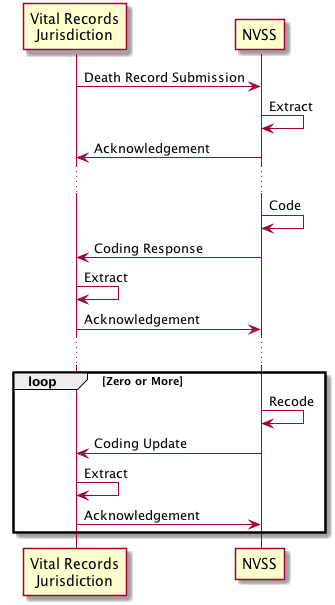
Figure 3 illustrates the sequence of message exchanges between a vital records jurisdiction and NVSS when a prior Coding Response needs to be subsequently updated. Coding updates should use a DemographicsCodingUpdateMessage or CauseOfDeathCodingUpdateMessage.
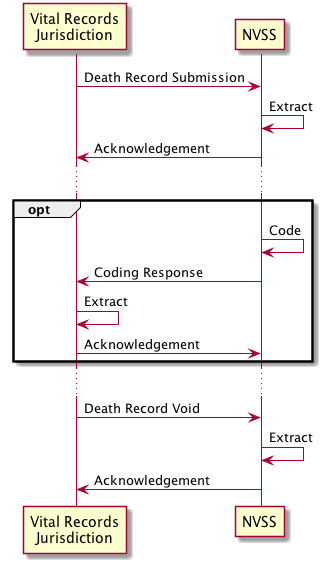
Figure 4 illustrates the sequence of message exchanges between a vital records jurisdiction and NVSS when an initial submission needs to be subsequently voided. Depending on timing, the initial submission may result in a Coding Response or not.
Records can also be pre-voided to inform NCHS that a specific set of certificate numbers will not be used in the future. This would just require the final three steps of figure 5: “Death Record Void”, “Extract” and “Acknowledgement”. Voiding death records should use a DeathRecordVoidMessage.
See note in previous section about Submission of death records regarding routing to NCHS and Jurisdictions.
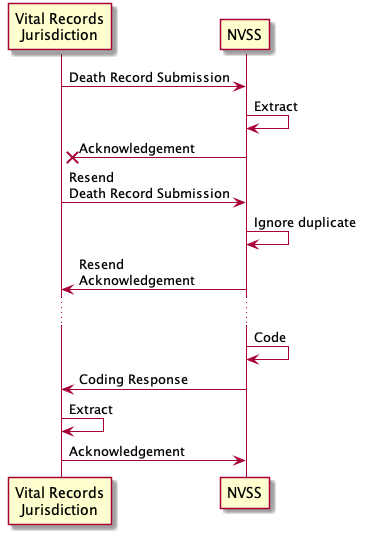
Figure 5 illustrates the case where the vital records jurisdiction does not receive a timely Acknowledgement to the Death Record Submission. Submissions can be retried providing the restrictions on Message and Header ids described in section 5 are followed.
It is recommended that the API server and each client attempt a maximum of 3 retries, waiting 4 hrs after the first attempt, 8 hours after the 2nd attempt, and 12 hours after the third attempt. If no acknowledgment is received within 12 hours of the third attempt, communication through another channel (e.g., phone or e-mail) should be used to identify and resolve the problem. This approach prevents retries from overloading NVSS in the case of transient outages.
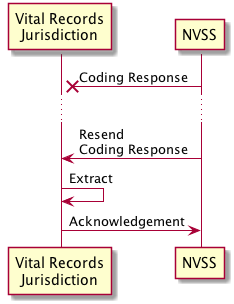
Figure 6 illustrates the case where the vital records jurisdiction does not receive a Coding Response. NVSS will not receive the expected Acknowledgement and this will trigger resending of the Coding Response.
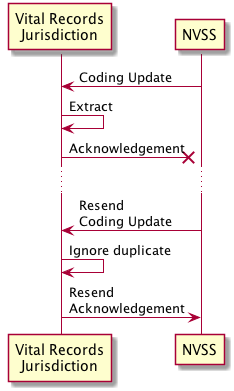
Figure 7 illustrates the case where the Acknowledgement of a Coding Update message is not received by NVSS. NVSS resends the Coding Update message, the jurisdiction resends the Acknowledgement and ignores the duplicate message.
The appropriate time to wait for an acknowledgement depends on several factors including the underlying mechanism for message exchange. E.g. an implementation based on polling for messages would have to factor in the interval between polls since that sets a lower bound on the time to wait for acknowledgements.

Figure 8 illustrates two message extraction failures:
Extraction Error Response should use a ExtractionErrorMessage. For submissions to NCHS, the set of current error messages are listed and described here.
For a given Death Record Submission or Coding Response:
In either scenarion, the recipient of the Extraction Error Response would need to investigate the cause of the failure using the information provided in the Extraction Error Response message.
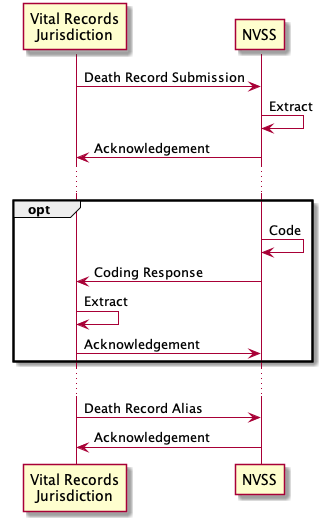
Alias records are optional records that are submitted only for National Death Index purposes and contain alternate spellings or “AKA”s captured on some death certificates. Some Alias records are literally just a mixed case or upper case version of the original record with no real significant differences. States vary in whether they even can report Aliases or not, and many never do. Alias records are accumulated, and cannot be voided or deleted separate from their accompaassociated ying death record.
Figure 8 illustrates the submission of a death message followed by an alias message. Alias messages can contain aliases for one or more of the following fields:
Alias records should be sent using a DeathRecordAliasMessage.